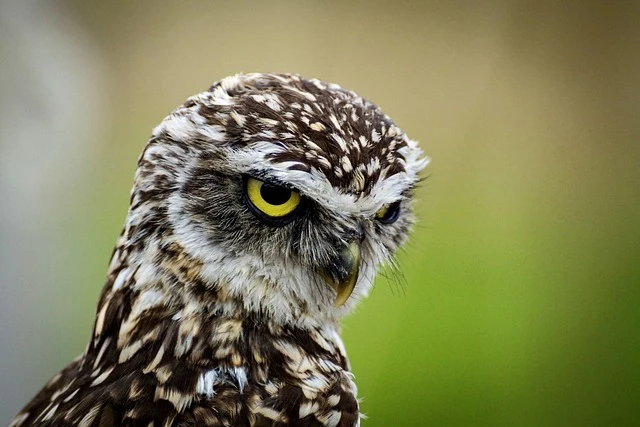Characteristics of Great Horned Owl
Habitat
Forests and urban areas
Diet
Carnivorous - small mammals, birds
Lifespan
15-25 years
Weight
1.4-2.5 kg
Length
Region
Americas
Owl Sound Characteristics
The owl sound repertoire is diverse and purposeful. From the iconic owl sound of hooting to various call and screech, these nocturnal birds use sound for territorial marking, mating, and communication. Each owl sound serves a specific function in their hunting and social interaction.
Hoot
The classic owl sound is a deep, resonant call consisting of several notes in sequence. This distinctive owl sound typically follows a pattern like "hoo-h'HOO-hoo-hoo." Great horned owls use this sound to establish territory and communicate with mates. The hooting owl sound can travel over a kilometer through forest at night, with males generally producing deeper hoots than females.
300-800 Hz
70-90 decibels
3-8 seconds
During evening and pre-dawn hours, especially in breeding season
Screech
A sharp, high-pitched owl sound used during aggressive encounters or when threatened. This alarming owl sound serves as a warning to potential predators or competing owls. The screeching owl sound is particularly common during territorial disputes and when protecting young. Young owls may also produce a similar sound when hungry.
800-2,000 Hz
75-95 decibels
1-3 seconds
During confrontations, when threatened, or to express alarm
Bill Snap
A sharp clicking owl sound produced by rapidly closing the beak. This defensive owl sound is often accompanied by hissing and wing spreading. Owls use this sound when cornered or protecting their nest. The snapping owl sound serves as a warning before more aggressive action is taken. This sound is common across many owl species.
500-1,500 Hz
60-80 decibels
0.1-0.5 seconds
When threatened at close range or defending nest
Whistle
A soft, high-pitched owl sound used primarily between mates and family members. This gentle owl sound helps maintain contact between paired owls and their offspring. The whistling owl sound is quieter than hoots and carries less distance. Female owls often use this sound to call their young or respond to their mate.
1,000-2,500 Hz
50-70 decibels
1-2 seconds
During pair bonding, feeding young, or quiet communication
Interesting Great Horned Owl Sound Facts
The owl sound of hooting can be heard up to 1.5 kilometers away on a quiet night
Each owl species has a unique hooting pattern that helps identify them
Male and female great horned owls produce different owl sound, with males having deeper hoots
Baby owls make hissing and screeching sound rather than hoots
Owls can produce over 13 different sound types for various situations
Interesting Facts about Great Horned Owl Sound
Owls can turn their heads up to 270 degrees
Their flight is nearly silent due to specialized feathers
They have excellent night vision, about 100 times better than humans
Great horned owls can carry prey much heavier than themselves
Their ears are asymmetrically positioned for better sound location
They are one of the few birds that regularly eat skunks
FAQs about Great Horned Owl Sound
Find answers to all your questions about Great Horned Owl sounds
Q Why do owls hoot?
Owls hoot primarily to establish territory and communicate with mates. This distinctive owl sound helps them maintain spacing between neighboring owls. The hooting owl sound also plays a crucial role during breeding season, when males use specific hooting pattern to attract females. Owls may increase their hooting frequency during territorial disputes.
Q Do all owls make the same sound?
Different owl species produce distinct owl sound pattern. The great horned owl's deep hooting differs significantly from the barn owl's screeching sound or the screech owl's trembling call. Each species has evolved its unique owl sound signature that helps them communicate effectively within their specific habitat and avoid confusion with other owl species.
Q When are owls most vocal?
Owls produce their most frequent sound during breeding season, typically late winter to early spring. The peak of owl sound activity occurs at dusk and pre-dawn hours. During these times, territorial owl sound increases as they establish boundaries. Some owl species also vocalize more during full moons when hunting visibility improves.
Q What sound do baby owls make?
Young owls produce distinctive high-pitched sound rather than hoots. These baby owl sound include hissing, screeching, and food-begging call. The juvenile owl sound helps parents locate their young in dark nest cavities. As young owls mature, their sound gradually deepens and develops into the characteristic adult owl sound pattern.
Q Can owls mimic other sound?
Unlike some birds, owls rarely mimic other sound. Their owl sound repertoire is instinctive rather than learned. Each owl species has evolved specific sound pattern suited to their ecological niche. The consistent nature of owl sound makes them reliable for species identification. Researchers can identify owl species in complete darkness solely by their distinctive sound.
Q How do owls produce their hooting sound?
Owls create their distinctive sound using a specialized voice box called the syrinx. This owl sound production organ is located at the base of the trachea. When air passes through the syrinx, it vibrates membranes to create the owl sound. The owl's large throat and beak shape further amplify and modify these sound, creating their characteristic hooting.
Q Do owls use sound for hunting?
Owls typically hunt silently, producing minimal sound while in flight. However, they use their exceptional hearing rather than owl sound to locate prey. Some owl species can detect prey sound from up to 75 feet away. After a successful hunt, owls may produce soft hooting or contact sound, particularly if they're bringing food to mates or offspring.
Q Can humans imitate owl sound effectively?
Humans can learn to imitate basic owl sound with practice. Cupping hands to create a resonant chamber helps produce a more authentic owl sound. Successful owl sound imitation requires mastering the correct rhythm and pitch pattern. Wildlife researchers use both vocal imitations and recorded owl sound to conduct population surveys and attract owls for study.
Most Downloaded birds Animal Sounds
Discover our most popular birds animal sounds
